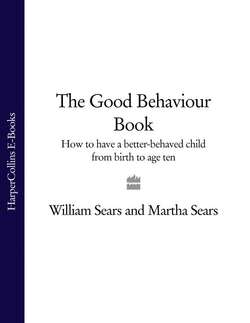Читать книгу The Good Behaviour Book: How to have a better-behaved child from birth to age ten - Martha Sears - Страница 41
growing out of it
ОглавлениеHow often have you heard, “Oh, just wait, he’ll grow out of it”? Though partially true, this lame excuse for not bothering to correct certain behaviours shows an incomplete understanding of child development. Growth and development used to be pictured like clothing sizes. The child outgrows an outfit, discards it, and puts on a bigger one that fits better. In reality, it’s not that simple. Children don’t always discard behaviours from one stage of development when they grow into another. Misbehaviour that is not corrected at one stage may linger into the next. On the other hand, don’t get too excited or worried when you see “good” or “bad” behaviour in your children. It may be a one-off thing that children try on for size and quickly discard when it doesn’t fit.
A child’s behavioural development is like a lift through a department store. The doors open and two children get off to find what they need on each floor. One child gets no sales help. He explores freely, puts on a bunch of new clothes, and gets back into the lift to go to the next floor. When he gets there he realizes that he still has the old clothes on underneath, and his new ones don’t fit that well. But he keeps going up on his own, putting new clothes over the old ones, carrying more and more excess baggage to each new floor. Soon he is weighed down with layers of clothing that he should have discarded earlier. Eventually, there is less and less room for new stuff.
The other little shopper gets the help of a wise and experienced disciplinarian. She has seen many children get out of that lift and knows just what he needs. “Let me help you try on some new clothes”, she offers, adding, “but we’ll have to figure out what to do with your old clothes. Some seem to fit you just fine, so we’ll keep them. They’ll be useful to you later. Let’s get rid of the ones that aren’t nice to make room for the ones that fit you better.” The disciplined child goes to each new floor not only with better clothes that fit but without excess baggage slowing his progress.
Which behaviours will children outgrow on their own and which need your attention? Behaviour that is linked to specific needs, tasks, or limitations of a certain developmental stage are probably best left alone; for example, thumb-sucking in a toddler, negativism in a two-year-old, shyness with strangers in a four- or five-year-old. Behaviour that may be understandable at a certain age but is nevertheless obnoxious should be worked on; for example, throwing food from the high chair, teasing the family dog, aggression toward parents. Children need limits that help them grow up to be polite, thoughtful, and caring. Your job as parents is to arm your children with the self-control tools that will help them make the transition from one developmental stage to the next.
Hands as tools. Along with learning how to get things, the year-old baby develops hand skills to manipulate what he gets. Doors are to be opened, taps turned, drawers pulled, dangling cords yanked, and waste cans emptied. Everything within walking and grabbing distance is fair game, or so he figures. To the inquisitive adventurer, the whole house is an unexplored continent, and he intends to leave no stone unturned.
Out of the mouths of babes. The development of language – verbal and body – makes parenting a bit easier. Baby can now begin to tell you what she needs with words. This new skill is a mixed blessing. While baby words are entertaining, they can also be frustrating as the parents struggle to understand just what “da-boo” means. Toddlers like to try on different noises to hear how they sound and how they affect their audience. They screech and squeal, yell and jabber. Sometimes their little baby words are pleasing to your ears, at other times they are nerve–wracking. Language also gives expression to feelings; a feisty “No” from your formerly agreeable child can raise your eyebrows.
